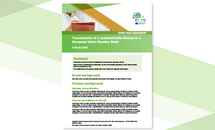Rapid risk assessment: Paediatric inflammatory multisystem syndrome and SARS -CoV-2 infection in children
Several countries affected by the coronavirus disease (COVID-19) pandemic recently reported cases of children that were hospitalised in intensive care due to a rare paediatric inflammatory multisystem syndrome (PIMS). The presenting signs and symptoms are a mix of the ones for Kawasaki disease (KD) and toxic shock syndrome (TSS) and are characterised, among others, by fever, abdominal pain and cardiac involvement. A possible temporal association with SARS-COV-2 infection has been hypothesised because some of the children that were tested for SARS-CoV-2 infection were either positive by polymerase chain reaction (PCR) or serology.
Executive Summary
In total, about 230 suspected cases of this new paediatric inflammatory multisystem syndrome temporally associated with SARS-CoV-2 infection (PIMS-TS) have been reported in EU/EEA countries and the UK in 2020, including two fatalities, one in the UK and one in France. These cases are being further investigated. So far, epidemiological studies have shown that children appear to be less affected by COVID-19. Only 2.1% of all laboratory-confirmed COVID-19 cases reported to The European Surveillance System (TESSy) were in the age group between 0 and 14 years of age.
To date, an association between SARS-CoV-2 infection and this new clinical entity of multisystem inflammation has not yet been established, although an association appears plausible. At current, the risk is assessed as follows:
- The overall risk of COVID-19 in children in the EU/EEA and UK is currently considered low, based on a low probability of COVID-19 in children and a moderate impact of such disease.
- The overall risk of PIMS-TS in children in the EU/EEA and the UK – is considered low, based on a verylow probability of PIMS-TS in children and a high impact of such disease.
While the clinical management of these children has absolute priority, data collection from EU/EEA Member States and the UK would strengthen the body of knowledge for this rare condition and allow for a better analysis of these cases. An analysis of surveillance data could clarify the incidence of KD/PIMS and identify the most affected age groups and risk factors for both conditions.
ECDC has agreed with the EU/EAA Member States and the UK to include PIMS as a possible complication to be reported for EU-level COVID-19 surveillance. Research efforts should aim at a) determining the role of SARS-CoV-2 in the pathogenesis of PIMS-TS and b) answering other significant remaining questions.
Risk communication is needed to raise awareness in the medical community about PIMS-TS and inform parents and caregivers about signs and symptoms. The importance of timely contact with a healthcare worker should be stressed. Risk communication should emphasise that PIMS-TS is a rare condition and that its potential link with COVID-19 is neither established nor well understood.






